OEMs and businesses that partner with a precision cutting service provider with multiple cutting methods, such as die cutting presses, waterjet cutters, automated static cutting tables, CNC cutting tables, and laser cutting tables will ensure their precision cutting project is completed as fast as possible with the highest degree of accuracy at the most cost-effective price. This guide will compare the different precision cutting services offered by MSI and go into more detail on the specific cutting tables available for customers to utilize.
MSI OFFERS PRECISION CUTTING SERVICES USING THE FOLLOWING METHODS:
- Die Cutting
- Waterjet Cutting
- CNC Cutting
- Laser Cutting
Let’s break down the unique advantages of die cutting, waterjet cutting, CNC cutting and laser cutting to get a better understanding of how these advanced precision cutting processes complement each other.
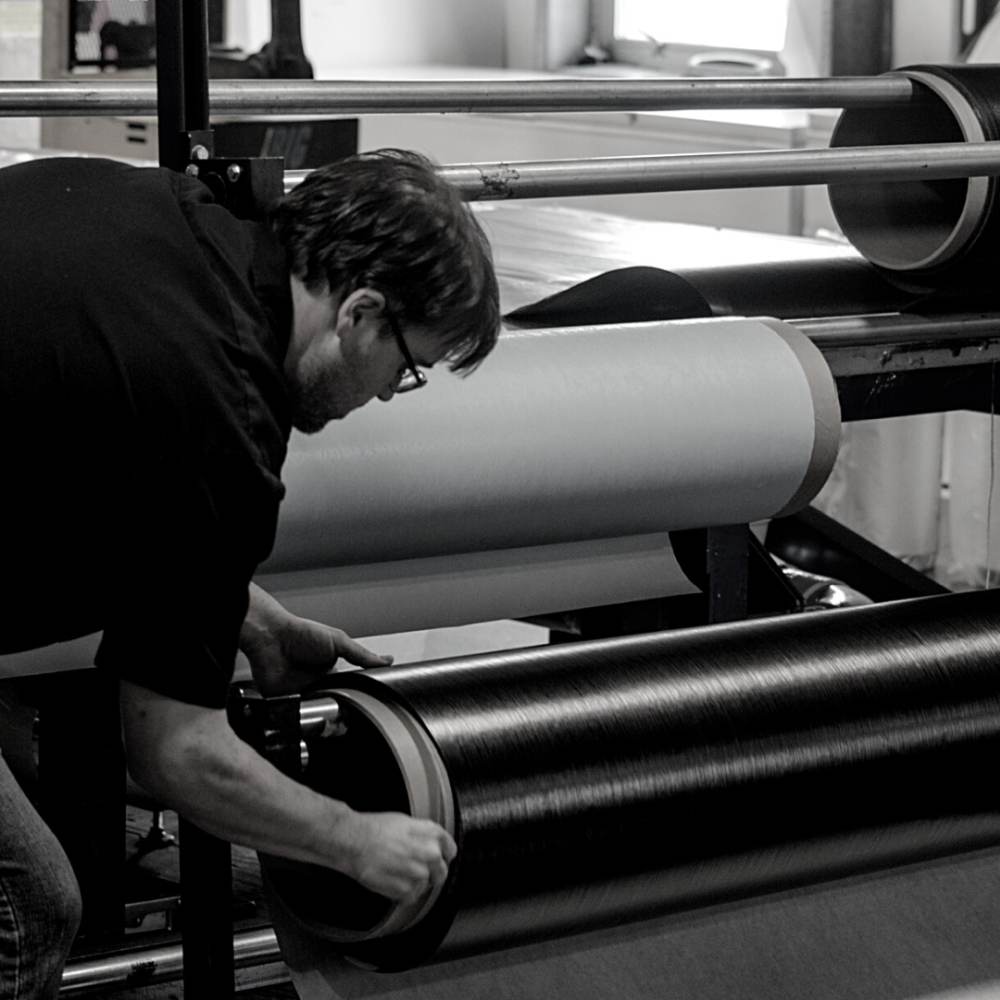
No time to read the entire guide now?
Not a problem! Enter your email below and we will send you a downloadable PDF version that you can get to on your own time.
What is Die Cutting?
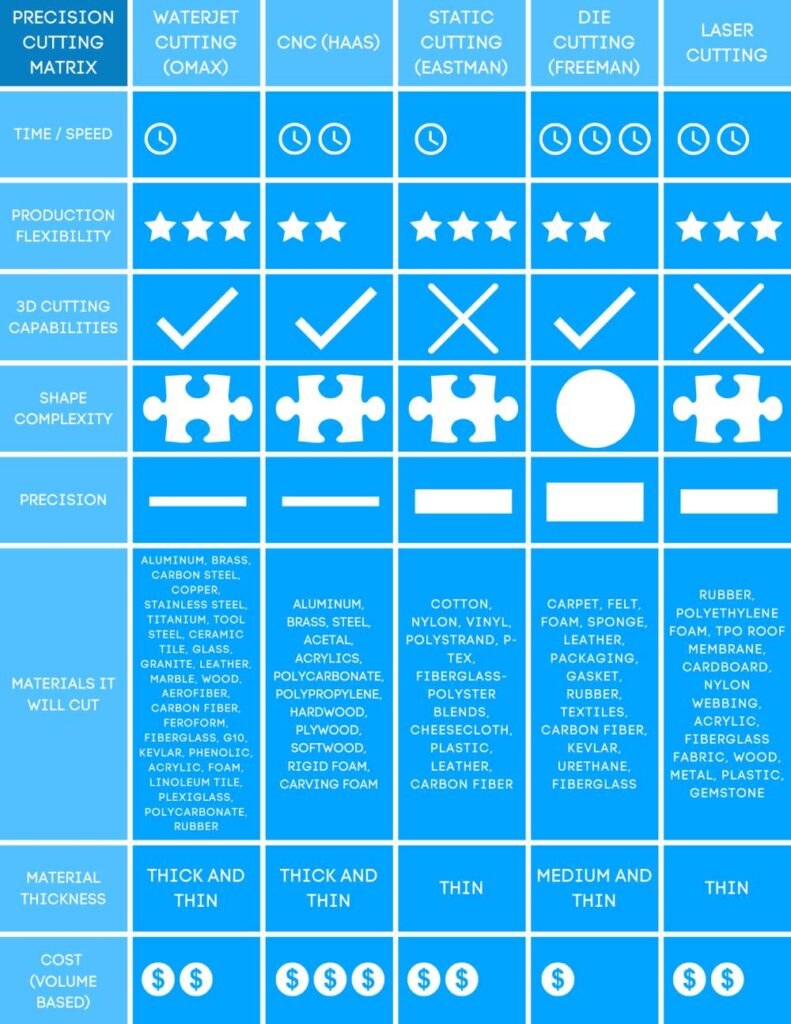
A tailored die cutting service from an experienced contract manufacturer will quickly and precisely shape materials and specialty fabrics with repeatable accuracy, typically within a 0.01-inch cutting tolerance, without ever sacrificing quality or performance.
Manufacturers and businesses in any industry requiring high volume manufacturing can leverage advanced die cutting to precisely cut uniform shapes. Industries such as aerospace, automotive, and medical are examples of the many industries that rely on extremely precise custom die cutting to provide high-quality results while maintaining regulatory compliance.
The extensive benefits that die cutting processes offer have resulted in die cutting becoming the industrial standard for the production of certain products such as washers, optical films, insulating foams, medical equipment, and vehicle components. In addition to the manufacturing of certain industry products, advanced die cutting processes can be leveraged for a variety of use cases including:
- Composite cutting
- Custom pattern cutting
- Carbon fiber cutting
- Ply cutting
- Leather cutting
- Foam cutting
- Kevlar cutting
- Rubber cutting
- Plastic cutting
- Fiberglass cutting
- Urethane cutting
- Membrane cutting
Die Cutting Methods
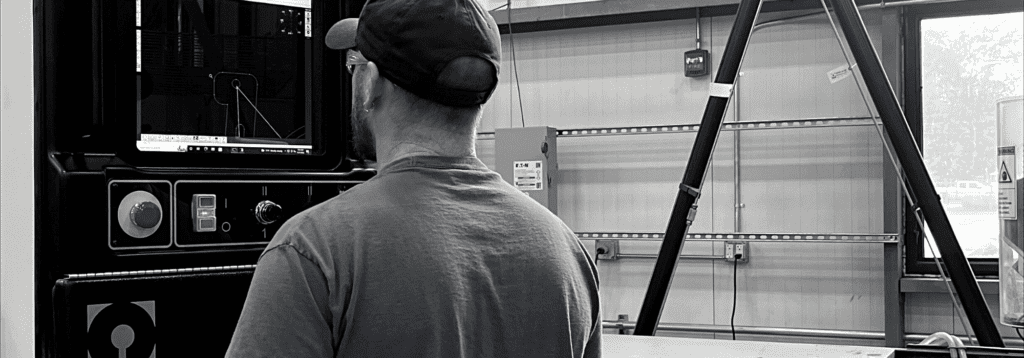
Manufacturers and businesses can partner with the right custom cutting service provider to leverage any of the main die cutting manufacturing processes to quickly and efficiently shape and cut a range of varying materials.
FLAT BED DIE CUTTING PROCESS
The flat bed die cutting process, also referred to as steel rule die cutting, is a fabrication process that utilizes a flatbed die cutting press and steel dies to cut raw materials into custom shapes and designs. This specific type of die cutting process is most suitable for custom cutting projects processing thicker materials (over ⅛ inch) as it is capable of exerting high pressures.
ROTARY DIE CUTTING MANUFACTURING PROCESS
The rotary die cutting manufacturing process leverages a rotary die press and custom-built cylindrical dies. This manufacturing process enables rapid material cutting as an entire sheet or web of raw materials can be fed into the press at one time. Once the machine is loaded, various shapes and designs can be cut.
What is Waterjet Cutting?
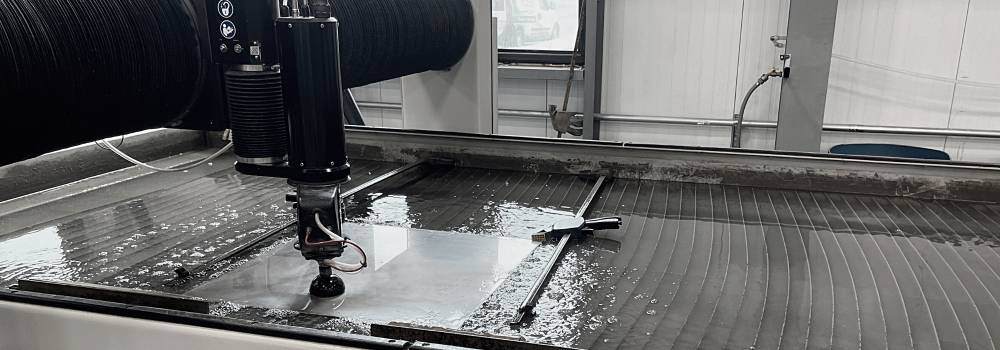
Waterjet cutting is an extremely versatile precision cutting service that can be used in a wide variety of industries for intricate designs and precision cutting jobs that require high tolerances. Waterjet cutting tables have a fast-set up time and can cut a wide range of materials without Heat Affected Zone (HAZ) or leaving heat-hardened edges. Due to fast programming and set-up times, waterjet cutting tables are great for creating prototypes and for short-run precision cutting projects.
From precision to fast cutting speeds, here are the characteristics and advantages associated with advanced waterjet cutting tables.
MATERIALS
Waterjet cutting tables can cut a range of materials, however since most fabric cutters don’t want their materials to get wet, waterjet cutting isn’t the best cutting process for fabrics. Waterjet cutters excel at cutting different materials based on strength, durability, corrosion resistance, and conductivity. The diversity of materials that can be cut with a waterjet cutter is one of the most attractive capabilities of this technology. Waterjet cutting processes can cut different materials based on strength, durability, corrosion resistance, and conductivity including:
- Metals – Waterjet cutters are capable of cutting all types of metals including hardened tool steel, aluminum, titanium, carbon steel, stainless steel, and red metals (copper, brass, and bronze).
- Naturals – Waterjet cutting machines use specialized techniques such as low-pressure pierce, water-only cutting, and vacuum assistance to cut a wide array of natural materials including glass, stone, wood, leather, and ceramics.
- Composites – Waterjet cutters precisely cut any fiber-reinforced material, including carbon fiber, fiberglass, and Kevlar reinforced personnel armor. Waterjet cutters are able to quickly and cleanly cut composites without the drawbacks that come with conventional machining such as tooling changes and restrictions due to heat buildup.
- Plastics & Rubber – Waterjet cutting allows for efficient and precise cutting of plastic and rubber materials such as foam, rubber, linoleum, Plexiglas, polycarbonates, and acrylic. Businesses that use waterjet cutting can navigate around the material distortion barrier that is often encountered while machining plastic on conventional Computer Numerical Control (CNC) machines by using the cold cutting method of a waterjet cutter.
THICKNESS
In addition to the type of materials that can be cut, a waterjet cutter is not limited by the material thickness. Waterjet cutters create a needle-thin cutting stream which can cut almost any shape and thickness, eliminating the need for additional machinery. This in turn reduces manufacturing costs and the amount of space needed.
The ability to cut materials and composites varying in thickness will ensure regulatory compliance in industries that require advanced cutting processes. While other cutting techniques may start to lose performance quality when cutting thicker materials, a waterjet cutter maintains reliable precision. Generally speaking, waterjets can cut through 12 inches of most materials, however, waterjet cutting is usually used on materials 3 inches thick or less.
COST-EFFECTIVENESS
Waterjet cutting also eliminates the need for edge cleanup, which makes the parts ready to use immediately, reducing labor costs and increasing productivity. This significantly accelerates the custom cutting process and saves time, contributing to an overall increase in efficiency.
SUPERIOR EDGE QUALITY
Cutting with a waterjet produces a smooth edge with no burn marks, cracking, or excess burrs. Since waterjet cutting is a cold cutting method, there are no heat-affected zones which can cause a change to the molecular composition decreasing the tensile strength of the material. In many cases, waterjet cutting also eliminates the need for secondary finishing which creates significant time savings and improves efficiency. The capability to provide superior edge quality is paramount for businesses that prefer water-only processes such as the automotive and defense industry.
PRECISION & ACCURACY
Waterjet cutters can maintain precision for nearly any material with an exceedingly small margin of error. The ability to meet tight tolerances ensures manufacturers continuously comply with the rigorous regulatory standards commonly found in the aerospace, automotive, and medical industries. Waterjet cutters like the OMAX 60120 JetMachining® Center can maintain tight cutting tolerances (+/-.005″) for sheets of steel, metal, or plastic at various thicknesses.
CUTTING SPEED
Waterjet cutting tables cut 5-10 times faster than wire electrical discharge machining (EDM) when cutting material less than 1 inch thick, but generally not as fast as plasma and laser cutters. Waterjet cutting speed is affected by several factors including material type, thickness, and desired edge quality. Compared to other competitive abrasive waterjet cutters in the industry, the OMAX 60120 JetMachining® Center has the fastest cutting speed at 350 in/min (8,890 mm/min).
RELIABILITY
The highly robust and reliable waterjet pump design is capable of operating over 1,000 hours between maintenance.
LOW ENVIRONMENTAL IMPACT
Waterjet technology only uses natural resources such as water and sand to reduce the harmful environmental impacts of the cutting process. There’s no air pollution and no exposure to potentially harmful toxins. Operators of the waterjet machines, as well as the end-user, are protected since no chemicals, heat, noxious fumes, liquids, or oils are used in, or caused by, the waterjet precision cutting process.
VALUE-ADDED SOFTWARE
Advanced waterjet cutters are equipped with value-added software and technology designed to meet and exceed the evolving precision cutting needs of manufacturers. Here are some of the exclusive proprietary technologies that come with the OMAX 60120 JetMachining® Center.
- Standard IntelliVISOR SE System Monitoring offers predictive maintenance and system monitoring to minimize unexpected downtime and increase efficiency.
- The exclusive EnduroMAX pump delivers faster and more efficient custom cutting. The pump has the highest nozzle horsepower in the industry.
Waterjet Cutting Methods
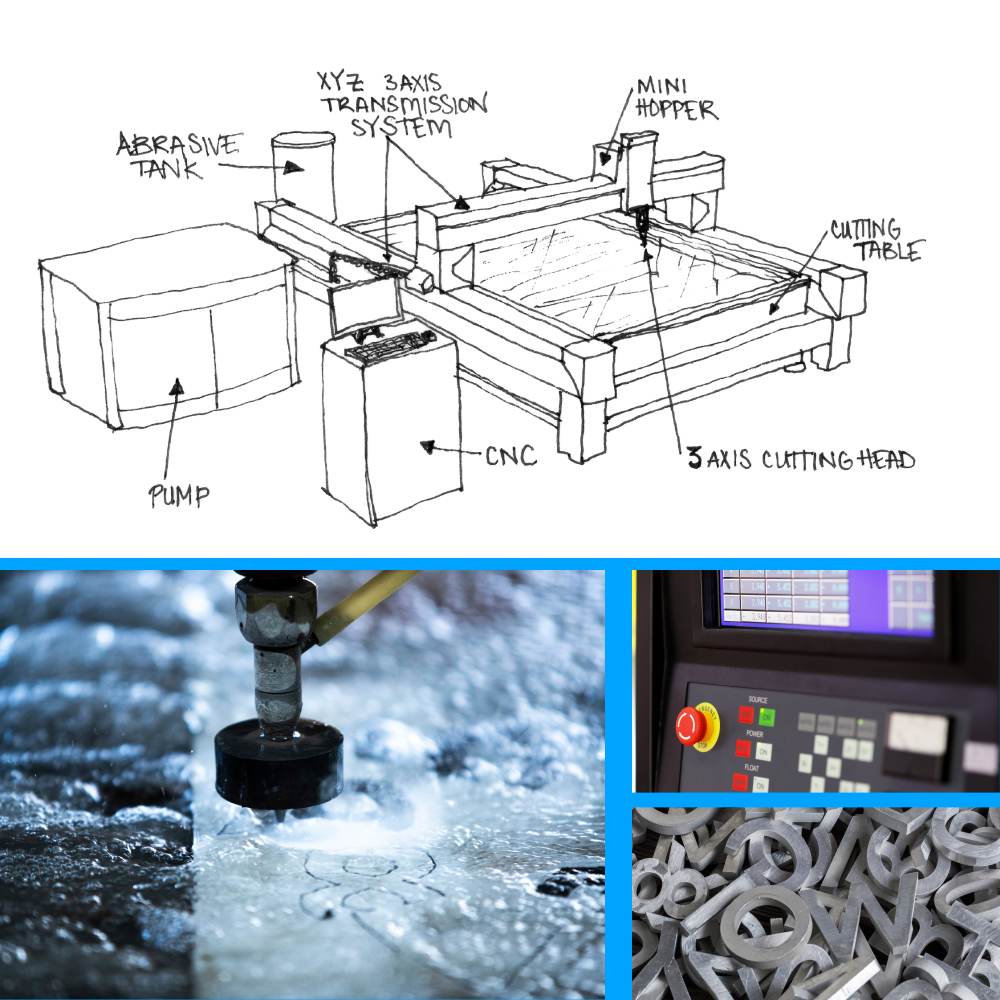
There are a variety of cutting methods associated with waterjet machines that businesses can leverage depending on their particular precision cutting needs.
- Pure Water Cutting – Pure water cutting is most suitable for cutting soft materials such as food, foams, papers, or plastics. The process is extraordinarily environmentally friendly because its main byproduct is pure, recyclable water.
- Abrasive Water Cutting – Abrasive water cutting is defined by the mixing of a hard, powdery material into the water jet such as garnet or corundum to act as an abrasive agent. This process is more suitable for hard materials such as metal, marble, and composites.
- Cold-Water Cutting – This process offers precise cutting without the detriment of a heat affected zone (HAZ). The no heat technology of waterjets allows for no part distortion, thermal damage, or stress damage to the finished product. The inclusion of cold water also enables clean cuts and increases the operators’ safety by eliminating the risks of burn damage.
- Low-Pressure Pierce – This waterjet cutting method helps prevent material from cracking by operating on low pressure. This process is more suitable for brittle materials like glass, stone, and ceramics.
- Wiggle or Dwell Piercing – Wiggle piercing, also referred to as dwell piercing, is a method in which water jet streams move repetitively across a very short distance to precisely cut the material. This process is suitable for making holes in thick materials.
What is CNC Cutting?
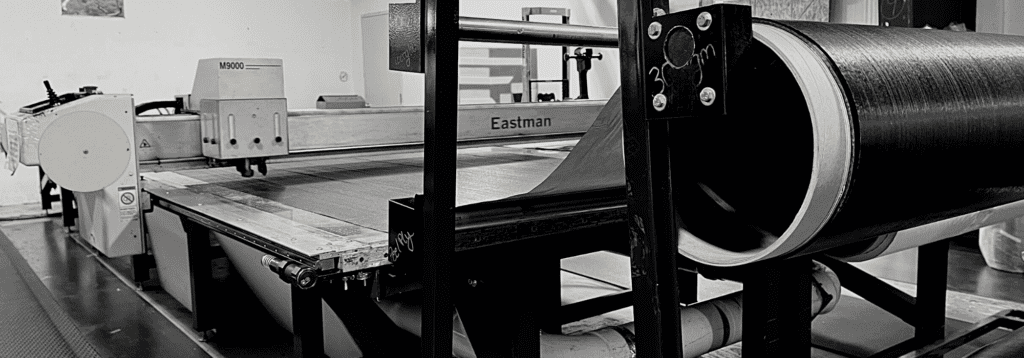
From complex shapes to one-off production runs, computer numerical control (CNC) static cutting table systems provide manufacturers a versatile and cost-effective cutting solution with superior advantages over manual cutting processes.
Original Equipment Manufacturers (OEMs) and businesses should understand what CNC cutting is and the benefits of using automated CNC static cutting tables so they can identify a contract manufacturer that has the resources and cutting capabilities to ensure their needs are met with pinpoint precision.
CNC cutting, or CNC machining, is a widely used automated manufacturing process that utilizes computerized controls to operate and manipulate cutting tools such as drills, lathes, and mills to shape stock material into custom parts and designs without the need of a manual operator directly controlling the machine. CNC cutting relies on digital instructions made on Computed Aided Manufacturing (CAM) or Computed Aided Design (CAD) software.
Automated CNC cutting machines cut with accuracy, repeatability, and are available in a range of lengths and widths to accommodate a wide variety of designs. There are two main types of automated CNC cutting systems – static and conveyor – both with unique advantages and disadvantages depending on the cutting project. Static cutting tables are durable and easy to use, while conveyor cutting tables are generally more expensive, use complicated software, and require frequent maintenance.
While waterjet cutting excels at cutting metals and thicker materials, automated static cutting tables are fabric-based and excel at single to low-ply cutting. OEMs and businesses that need to cut complex shapes for smaller production runs can avoid die cutting and custom die by leveraging automated static cutting tables.
MATERIALS
The Eastman M9000 static cutting table can cut sheets of fabrics up to 8 feet wide and 20 feet long and is capable of cutting materials including but not limited to cheesecloth, plastic, cotton, leather, nylon, and vinyl as well as more high-tech materials such as carbon fiber, p-tex, and fiberglass-polyester blends.
THICKNESS
Automated static cutting tables can cut thin layer films at a quarter-inch thickness.
CUTTING SPEED
The Eastman M9000 static cutting table can accurately cut virtually any flexible fabric at speeds up to 60 inches per second (152.4 cm/second).
RELIABILITY
The Eastman M9000 static cutting table maintains reliability for 2,000+ hours of normal operation use.
VALUE-ADDED SOFTWARE
Advanced automated static cutting tables have several software add-on capabilities that enable manufacturers to accomplish their tasks quickly and with better results. Eastman’s operating control software, cutPRO, is a user-friendly, all-inclusive platform that makes it easier to import files in various formats, manage cut speeds, accelerations, and tool types per material requirements.
REPEATABILITY & SCALABILITY
One of the most valued benefits of CNC cutting is the repeatability of cutting materials. When OEMs and businesses need their products cut, it’s critical that every product is cut with the same quality and is identical to one another. If a company needs 100 complex patterns cut out of carbon fiber, all 100 need to be cut the same. This high level of consistency cannot be achieved using a manual cutting process.
However, design parameters and specifications can be digitally entered into a CNC static cutting machine’s software to ensure consistency one cut after another, affording OEMs and businesses flexible scalability.
PRODUCTIVITY
Conventional manual cutting produces inefficiencies and is prone to human error that results in cutting jobs taking longer than they need. A CNC cutting machine enables greater productivity by making cuts faster and more accurately. A CNC static cutting table programmed with the latest CAD software can move more efficiently and reduce unnecessary movements leading to a more streamlined cutting process. In a highly competitive manufacturing environment, productivity is the key to unlocking greater profitability. A contract manufacturer that utilizes automated high-speed machining can complete cutting projects quicker and enable OEMs and businesses to increase their order capacities to meet the growing demands of their customers.
At MSI, we have two Eastman M9000 static cutting tables that can cut thin layer films at a quarter-inch thickness, cut sheets up to 8 feet wide and 20 feet long, operate 24 hours a day, and cut virtually any material at speeds of up to 60 inches per second with an accuracy of +/- .030 inches. The Eastman M9000 static cutting table is capable of cutting materials including but not limited to cheesecloth, plastic, cotton, leather, nylon, and vinyl as well as more high-tech materials such as carbon fiber, p-tex, and fiberglass-polyester blends.
Businesses that take advantage of automated CNC static cutting tables can leverage the technology to help them scale and achieve their precision cutting goals. From improved accuracy to lower costs, here are four advantages of using a contract cutting service that uses advanced CNC cutting tables like the Eastman M9000.
COST-EFFECTIVENESS
Cutting complex shapes, no matter the production size, can be a time-consuming and labor-intensive process which is why a majority of OEMs and businesses outsource the cutting process to contract manufacturers.
While die-cutting machines have the capability to cut complex shapes, OEMs and businesses that have a smaller production run do not want to spend the money on designing a custom die which can cost anywhere between $1,000 – $10,000 depending on the complexity of the shape. OEMs and businesses that need complex shapes for smaller production runs can avoid costly custom dies by using CNC static cutting tables.
PRECISION & ACCURACY
One of the greatest benefits of contract cutting is improved accuracy. Advanced CNC static cutting tables can cut materials with an accuracy of +/- .030 inches, which is extremely hard to achieve and maintain using manual cutting processes. In some industries, the margin of error must be close to non-existent. CNC static cutting tables provide OEMs and businesses high-quality finished products that ensure customer satisfaction and the needed assurance that if their industry requires precise tolerances, they’re continuously meeting rigorous standards and regulatory compliance.
Alternatively, customers can take advantage of MSI’s HAAS VF-4 CNC mill machine, which has full XYZ travel. Vertical milling machines provide users with increased visibility, which can be particularly useful on slower projects that require special attention to detail. They are very precise, user-friendly, and generally more affordable than their horizontal counterparts. MSI’s HAAS VF-4 CNC mill machine can be leveraged for a variety of use cases including:
- Plung cuts
- Drilling cuts
- Single-side projects
- Projects with detail work that require a lot of visibility
What is Laser Cutting?
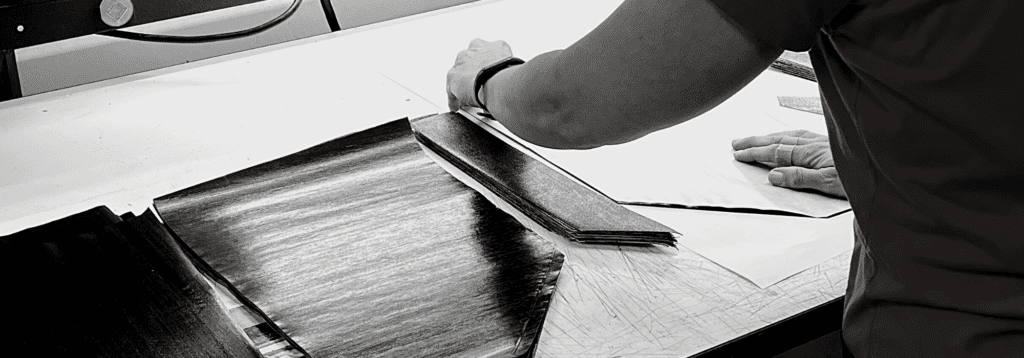
Laser cutters create patterns and designs by using a powerful, 5 micrometer laser beam to cut melt, burn, or vaporize materials. This thin, focused, laser beam can either cut or etch materials under +/- .25” into custom designs, patterns, and shapes as specified by the designer. Given a .dxf file with the needed shape, OEMs can automatically arrange an arrange of those shapes to be cut at once. This laser cutting process is ideal for several materials, including rubber, polyethylene foam, TPO roof membrane, nylon webbing, acrylic, wood, fiberglass fabric, metal, plastic, and gemstone.
Today, laser cutting is used in industries such as aerospace, automotive, electronics, and medicine. One of the most common applications is for cutting fabric because of the lasers’ ability to deliver clean cuts and smooth finishes. Because the laser does not physically touch the material being cut, there is no distortion or pulling. It leaves a melted edge that will prevent fraying, which is particularly beneficial on webbing and fiberglass fabric.
Partnering with a Contract Manufacturer with Diverse Precision Cutting Capabilities
Advanced precision cutting tables including waterjet cutters and automated static cutting tables provide OEMs and businesses a complementary and versatile cutting solution with superior advantages over traditional manual cutting processes.
By understanding the unique advantages of each cutting table, OEMs and businesses can choose a contract cutting partner that has the equipment and cutting capabilities that best fits their order capacity and unique cutting requirements. Before cutting into your bottom line, discuss your precision cutting project with an experienced contract manufacturer to ensure your materials are cut with the cutting table best suited for your production run.



